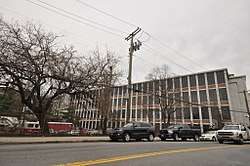Alexander Smith Carpet Mills Historic District
|
Alexander Smith Carpet Mills Historic District | |
 View from Walnut Street | |
  | |
| Location | Roughly bounded by Saw Mill River Rd., Orchard St., Lake and Ashburton Aves., Yonkers, New York |
|---|---|
| Coordinates | 40°56′33″N 73°53′1″W / 40.94250°N 73.88361°WCoordinates: 40°56′33″N 73°53′1″W / 40.94250°N 73.88361°W |
| Area | 38 acres (15 ha) |
| Built | 1871 |
| Architectural style | International Style |
| NRHP reference # | 83001832[1] |
| Added to NRHP | August 11, 1983 |
The Alexander Smith Carpet Mills Historic District is a national historic district located at Yonkers, Westchester County, New York. It includes 85 contributing buildings. It encompasses 19 stylistically varied mill buildings and six rows of workers' housing. They were developed between 1871 and 1930 along the banks of the Saw Mill River. The main mill building was originally built in 1871 and expanded between 1876 and 1883. It is a three-story, rectangular building, 52 bays wide and five bays deep in the Second Empire style. It features a four-story tower and a five-story tower. The workers' housing, known as Moquette Row, North and South, was built between 1881 and 1886. The carpet works were developed by Alexander Smith (1818-1878) The company closed the Yonkers mills and relocated to Greenville, Mississippi, in 1954.[2] It was later absorbed into Mohawk Carpet, later Mohasco Corporation.[3] The carpet weaving industry was revolutionized by looms invented in this plant by Alexander Smith and Halcyon Skinner.[4]
It was added to the National Register of Historic Places in 1983.[1] Today, members of the YoHo Artist Community work out of two of buildings, located at 540 and 578 Nepperhan Avenue.[5]
See also
| Wikimedia Commons has media related to Alexander Smith Carpet Mills. |
References
- 1 2 National Park Service (2009-03-13). "National Register Information System". National Register of Historic Places. National Park Service.
- ↑ An Industry Moves South, Readers Digest, March, 1956
- ↑ Karen Morey Kennedy and Austin N. O'Brien (April 1983). "National Register of Historic Places Registration:Alexander Smith Carpet Mills Historic District". New York State Office of Parks, Recreation and Historic Preservation. Retrieved 2011-01-01. See also: "Accompanying 31 photos".
- ↑ New York: A Guide to the Empire State (1940), p. 374, at Google Books
- ↑ Fallon, Bill (March 3, 2008). “Industrial Arts: Carpet Mills Become Studio Central.” Westchester County Business Journal, p. 49.
External links

